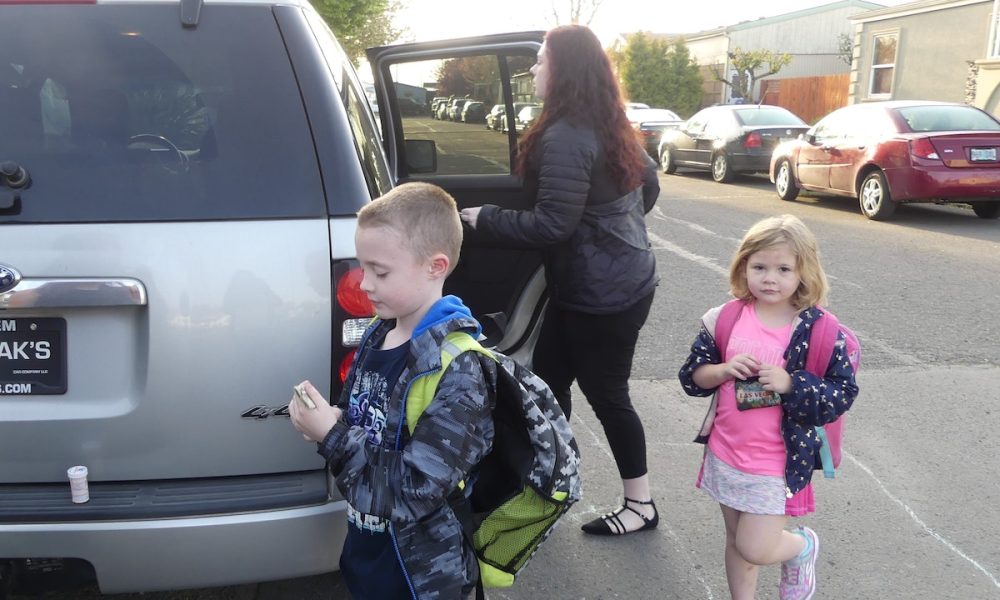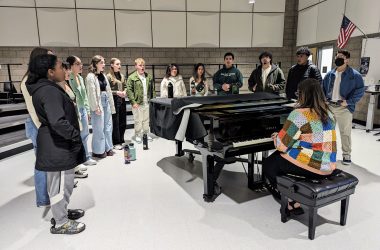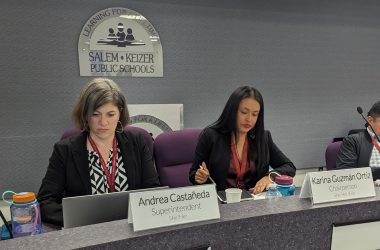
Rebekah Mitchell, center, drops her son Kaiden and daughter Kendra off at daycare the morning of Thursday, April 25. (Rachel Alexander/Salem Reporter)
Hundreds of Salem-Keizer families are having requests to transfer kids to out-of-neighborhood schools denied following a school board decision to approve new attendance boundaries for district schools.
Nearly 700 students applied to attend a school other than the one dictated by their home address due to boundary changes. More than half have been rejected, district spokeswoman Lillian Govus said, “because of the need for the boundary adjustment to do what the boundary adjustment was designed to do.”
Families request transfers to a non-neighborhood school for many reasons, including proximity to child care or a specific academic or career program at a particular school. But changes to school boundaries have driven an increase in requests this year, with many parents seeking to keep younger siblings with older ones.
Brandy Parkison, who runs a daycare out of her home in the Copper Creek area, said the changes have been a challenge for her and the families she cares for.
“It’s messing with a lot of families that have multiple children,” she said.
Parkison’s home used to be within the boundary for Clear Lake Elementary, but with the changes, she’s now in the Hammond Elementary boundary.
Many of the kids she cares for attend Clear Lake. Those in third, fourth or fifth grade next year will be able to stay at the school, but younger siblings have to switch to Hammond, or petition for an exception.
School staff mailed letters to all families impacted by a boundary change in February outlining their options and noting there was no guarantee transfer requests would be approved.
If a family requested, older siblings were automatically approved to attend their new neighborhood school with a younger sibling. But nearly every request for a younger sibling to start school or continue at the old neighborhood school has been denied, Govus said.
“If your kids want to stay together, they can stay together but it has to be at the new school, it can’t be at the old school,” Govus said.
She said there were a handful of exceptions where people requesting transfers were seeking to remain in schools that were not overcrowded, or where there were other extenuating circumstances.
“We try to work with people to the extent that we can,” she said.
Rebekah Mitchell is one of Parkison’s customers who’s upset by the changes. She lives in the Kennedy Elementary boundary, but her oldest son, Kaiden, is in second grade at Clear Lake. He was able to transfer there because it was the closest school to daycare.
Mitchell said Kaiden will be able to stay at Clear Lake next year. Her daughter, Kendra, will start kindergarten in the fall, and Mitchell petitioned for her to attend Clear Lake with her brother. But last week, her petition was denied.
She doesn’t want to put her son in a new school halfway through elementary school and force him to start over making friends, she said.
But she’s worried Parkison, who already transports her charges to several local schools, won’t be able to add Hammond or Kennedy to the list. Mitchell starts work at 8 a.m. and can’t take them herself.
“I don’t want to lose out on amazing childcare because they rezoned all these boundaries,” Mitchell said. “It’s incredibly hard to find good daycare in the first place.” She’s filed an appeal with the district.
Parkison said other daycare providers are facing similar challenges. She already has her daughter on staff helping with transportation and said she might have to add another employee if families need rides to more schools that start within a few minutes of each other.
Current middle and high school students affected by boundary changes are able to remain at their existing schools, though incoming sixth graders and freshman will go to the school in their new boundaries.
“We did it in such a way as to try to minimize as much disruption to families as possible,” Govus said.
More than half the transfer requests districtwide were for elementary schools.
In the past, decisions about approving transfer requests were largely left up to individual principals.
This year is the first those decisions have been made by district staff so they can keep an eye on enrollment and make sure the number of students at each school works with the district’s goal to reduce overcrowding and allow for planned school construction.
“We’ve got to really track how the populations are shifting,” Govus said.
The changes are hitting some families who don’t live in a neighborhood where school boundaries shifted.
Annie Ortiz and her family moved from one south Salem address to a new one last year. She opted to keep her third-grade son at his existing school, McKinley Elementary, though her new neighborhood was in the Salem Heights boundary.
Now, her daughter is entering kindergarten. Ortiz petitioned to have her attend McKinley with her brother, but was denied because of the number of similar requests happening due to boundary changes.
“I thought it was going to be easy to just keep her with her brother,” she said.
Not every transfer request has been denied. Ortiz’s husband works at North Salem High School, and she successfully applied for her older daughter to attend school there. But her two elementary school children are more of a challenge.
Her son can’t get a bus to McKinley because it’s an out-of-neighborhood school, and the family lives too close for transportation to Salem Heights. She has also filed an appeal.
“I didn’t want him to lose his friends,” she said of her son.
Reporter Rachel Alexander: (503) 575-1241 or [email protected]
WILL YOU SUBSCRIBE? If you haven’t signed up for a digital subscription to Salem Reporter, please do so to support this kind of local news reporting, brought to you by a team of professional reporters. For $10 a month, you hire that team to work for you all month digging out the news of Salem. Sign up HERE.

Rachel Alexander is Salem Reporter’s managing editor. She joined Salem Reporter when it was founded in 2018 and covers city news, education, nonprofits and a little bit of everything else. She’s been a journalist in Oregon and Washington for a decade. Outside of work, she’s a skater and board member with Salem’s Cherry City Roller Derby and can often be found with her nose buried in a book.









